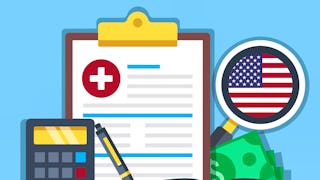18 Highest-Paying Travel Nursing Jobs
March 31, 2025
Article



Recommended experience
Beginner level
Individuals currently in the healthcare sector, as a provider, payer, or administrator. Individuals pursuing a career change to the healthcare sector
Recommended experience
Beginner level
Individuals currently in the healthcare sector, as a provider, payer, or administrator. Individuals pursuing a career change to the healthcare sector
Explain how the delivery of healthcare in the U.S. is organized and financed
Compare the American healthcare system to those existing in other countries
Identify emerging trends affecting healthcare delivery, including the American population, technologies, genetic testing, and patient engagement

Add to your LinkedIn profile
19 assignments


Add this credential to your LinkedIn profile, resume, or CV
Share it on social media and in your performance review

This course is best suited for individuals currently in the healthcare sector, as a provider, payer, or administrator. Individuals pursuing a career change to the healthcare sector may also be interested in this course.
This course is the continuation of An Overview of the U.S. Healthcare System course . If you have not yet taken the introductory course, it is recommend that you complete that course prior to this course. The foundational knowledge from the introduction is carried through in this deeper dive into learning about how the U.S. Healthcare System operates. This course provides an insight into the payment architecture, cost and value of prescription drugs, spending, outcomes, and social accountability of the American Healthcare System. Throughout this course, you will be given the opportunity to evaluate your understanding through engagement in course discussions, application of course concepts to course assignments, and through completion of content quizzes along the way.
In this module, we will discuss the basic mechanics of paying for volume and how it affects physician payment. Looking ahead, in the U.S., traditional payment approaches for healthcare providers, such as fee-for-service and per diem payments, are being slowly phased out due to concerns about excessive and unnecessary utilization of healthcare services contributing to rising healthcare costs. Additionally, the US healthcare system is undergoing a slow shift from paying providers for volume to paying them for value, which means they are rewarded or penalized based on their quality of care and efficiency.In this module we will explore these traditional payment arrangements as well as the new methods and developments. We will examine the benefits and drawbacks to the different methods and how they affect provider performance.
8 videos9 readings5 assignments2 discussion prompts
In this module, we will now focus our attention on the diffusion of pricing and prescription medications in the U.S. Prescription drugs account for over 10% of total healthcare spending in the U.S. and are increasingly important for managing chronic conditions. However, the regulatory process for approving new drugs has long been a source of controversy, with stakeholders contending it is inefficient and contributes to rising drug costs. To better understand these issues, we will explore how drugs are developed and regulated.We will also continue on in our exploration of initiatives addressing the cost and value of prescription drugs in this module. Rising drug costs have been a major concern for both the private and public sectors, with initiatives ranging from value-based contracts to federal and state laws aimed at negotiating drug prices and limiting out-of-pocket expenses for patients. While the impact of many of these initiatives is yet to be evaluated, the hope is that they will ultimately result in affordable access to prescription drugs for all Americans.
5 videos3 readings5 assignments1 peer review
Healthcare financing and delivery vary across the globe, with different approaches to public and private sector involvement, as well as universal health coverage. The U.S. has a mixed model with both public and private sector involvement, but lacks universal coverage, while other countries rely predominantly on either the public-or private-sector with varying levels of out-of-pocket spending. In this module, we will explore the key differences between the U.S. healthcare system and the healthcare systems of other countries. We will examine the advantages and disadvantages of various healthcare systems models and evaluate the performances of these systems. How do you feel currently about your quality of care? Perhaps learning about different models of healthcare delivery around the world will give you a new perspective.
4 videos4 readings4 assignments1 discussion prompt
In this module, we will examine the tax-exempt status of nonprofit hospitals in the U.S., which generate millions in annual revenue but are exempt from paying income, property, and sales taxes. We will also discuss the qualifications that allow these hospitals to enjoy this favorable tax treatment, and the community benefits they are expected to provide in return. Nonprofit hospitals in the U.S. face a unique challenge of providing community benefits while also competing in a highly competitive market for healthcare services. However, research has found that charitable spending can be a source of competitive advantage, leading to increased customer loyalty and financial benefits. We will reflect on the tax exemptions and community benefits as well as the social accountability for healthcare delivery more in this module.
8 videos6 readings5 assignments1 peer review



Founded in 1898, Northeastern is a global research university with a distinctive, experience-driven approach to education and discovery. The university is a leader in experiential learning, powered by the world’s most far-reaching cooperative education program. The spirit of collaboration guides a use-inspired research enterprise focused on solving global challenges in health, security, and sustainability.

Northeastern University
Course
University of Illinois Urbana-Champaign
Course

Stanford University
Course

University of Pennsylvania
Course





Unlimited access to 10,000+ world-class courses, hands-on projects, and job-ready certificate programs - all included in your subscription
Earn a degree from world-class universities - 100% online
Upskill your employees to excel in the digital economy
Access to lectures and assignments depends on your type of enrollment. If you take a course in audit mode, you will be able to see most course materials for free. To access graded assignments and to earn a Certificate, you will need to purchase the Certificate experience, during or after your audit. If you don't see the audit option:
The course may not offer an audit option. You can try a Free Trial instead, or apply for Financial Aid.
The course may offer 'Full Course, No Certificate' instead. This option lets you see all course materials, submit required assessments, and get a final grade. This also means that you will not be able to purchase a Certificate experience.
When you purchase a Certificate you get access to all course materials, including graded assignments. Upon completing the course, your electronic Certificate will be added to your Accomplishments page - from there, you can print your Certificate or add it to your LinkedIn profile. If you only want to read and view the course content, you can audit the course for free.
You will be eligible for a full refund until two weeks after your payment date, or (for courses that have just launched) until two weeks after the first session of the course begins, whichever is later. You cannot receive a refund once you’ve earned a Course Certificate, even if you complete the course within the two-week refund period. See our full refund policy.
Yes. In select learning programs, you can apply for financial aid or a scholarship if you can’t afford the enrollment fee. If fin aid or scholarship is available for your learning program selection, you’ll find a link to apply on the description page.
Financial aid available,